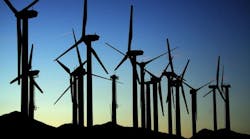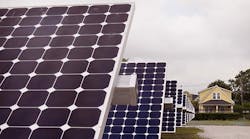Although the latest construction spending data and forecasts for the electric utility market do not reflect any major year-over-year growth, a fascinating array of new power plants are scheduled to come on line in the next year or are on the drawing boards. Natural gas-powered plants, wind farms and utility-scale solar fields account for most of the new construction.
The 2015 Dodge Construction Forecast pointed to $20.5 billion in utility construction, a 9% drop from 2014 and a 39% drop from the recent high of $52.2 billion in 2012. But its 2014 forecast showed construction of gas-fired power plants was up 141% and an analysis by Electrical Marketing’s editors of data from the Energy Information Administration (EIA) on the 100 largest proposed generating plants revealed that 66% of the new proposed plants would be powered by natural gas. Wind will account for 20% of this new generating capacity, according to the EIA data, followed by solar (7%); coal (2%); nuclear (2%); and waste heat recovery (1%).
EIA said that in total, electric generating companies expect to add more than 20 gigawatts (GW) of utility-scale generating capacity to the power grid this year. The additions are dominated by wind (9.8 GW), natural gas (6.3 GW), and solar (2.2 GW). It also said in a press release that the addition of more natural gas, solar and wind generating capacity follows the pattern of the past several years.
“Wind additions are largely found in the Plains states, with nearly 8.4 GW, or 85% of total wind additions, found between North Dakota and Minnesota in the north, to Texas and New Mexico in the south,” the EIA release said. “Utility-scale solar additions of systems with at least one megawatt of capacity are dominated by two states — California (1.2 GW) and North Carolina (0.4 GW) — which combined for 73% of total solar additions. Natural gas additions are spread throughout the country, but Texas is adding more than double any other state (1.7 GW, 27% of total natural gas additions).”
While few new nuclear plants will be coming online, those now under construction are massive. EIA said Tennessee Valley Authority’s Watts Bar 2 nuclear facility in southeastern Tennessee will have a summer nameplate capacity of 1.1 GW. It’s expected to begin producing power in December and will be the first new nuclear reactor brought online in the United States in nearly 20 years. Two other nuclear plants now under construction by Georgia Power Co. and South Carolina Electric & Gas Co. will each also produce more than a gigawatt in power when they come online in 2019 and 2020. Georgia Power is building two units that will each produce 1.1 GW, and the utility expects the new plant to power 1.4 million homes by 2020. (A gigawatt can power over 700,000 homes).
The largest natural gas plant now under construction is in Texas and will also produce over a gigawatt in power when completed in 2018. It’s being built by Rockwood Energy Center LLC in Hill County, Texas. Another generating plant powered by natural gas is now being built in Harris County, Texas, and it will be nearly as large. The CPV PonderKing Energy Center will produce 900 megawatts (MW) when complete in 2019.
Giant power plants are also underway or planned using solar and wind. With 1,000 wind turbines and a capacity of up to 3 GW, the Chokecherry and Sierra Madrea Wind Energy Project in Carbon County, Wyo., when completed in 2018 will be built on less than 2,000 acres in a 320,000-acre ranch.
The largest solar project now underway is in Imperial County, Calif. The Tenaska Imperial Solar Energy Center is being built in phases in the California desert will have close to 4 million PV panels when complete. Since 2013, the Tenaska Imperial South phase of the project has utilized about 2 million PV panels to provide power to more than 40,000 San Diego Gas & Electric customers. The Tenaska Imperial West phase, of the project, which is roughly the same size as the first phase, is expected to go live next year.












